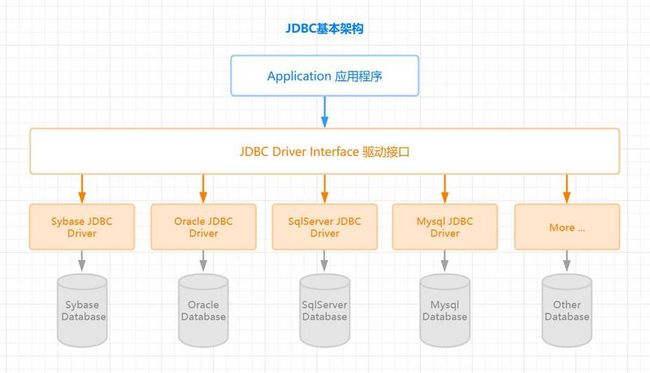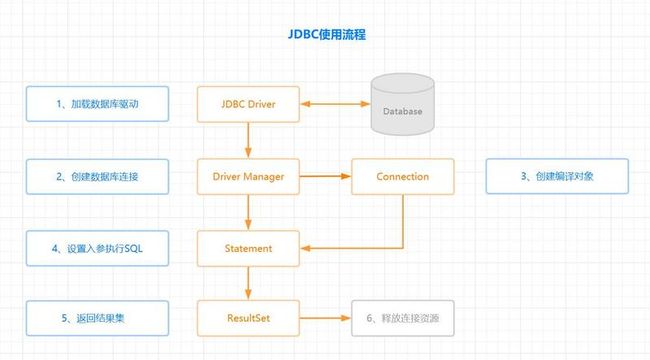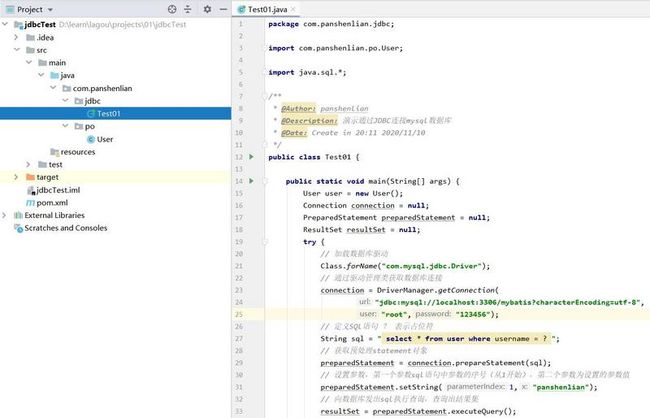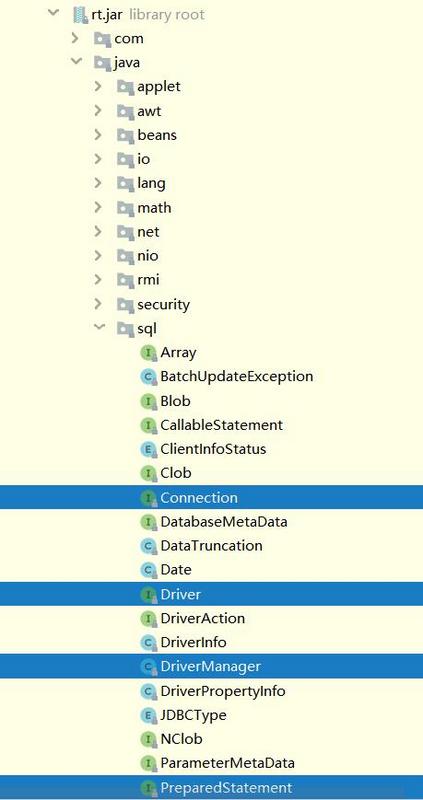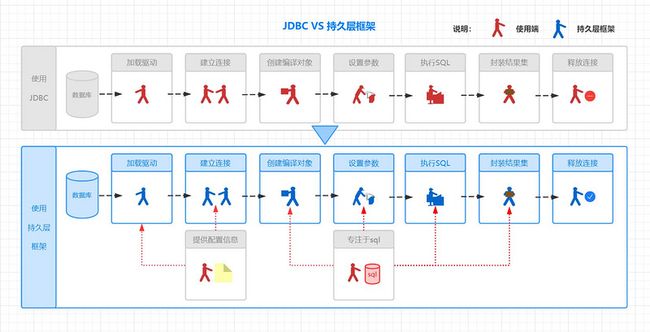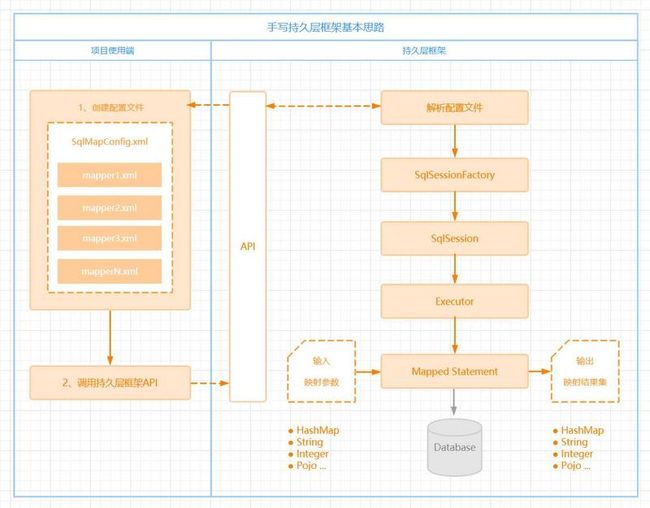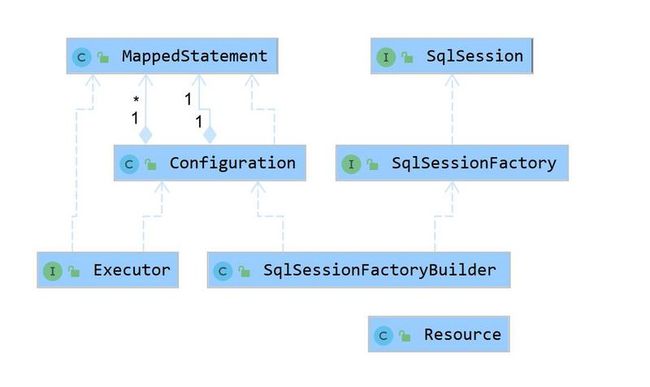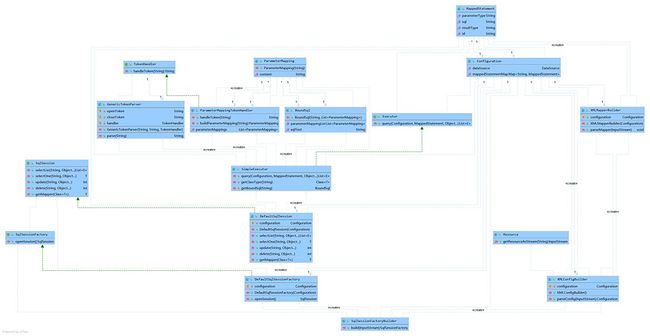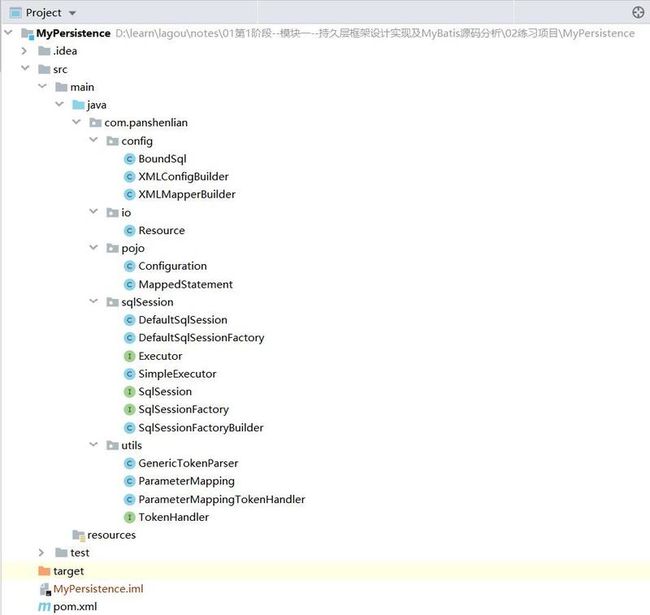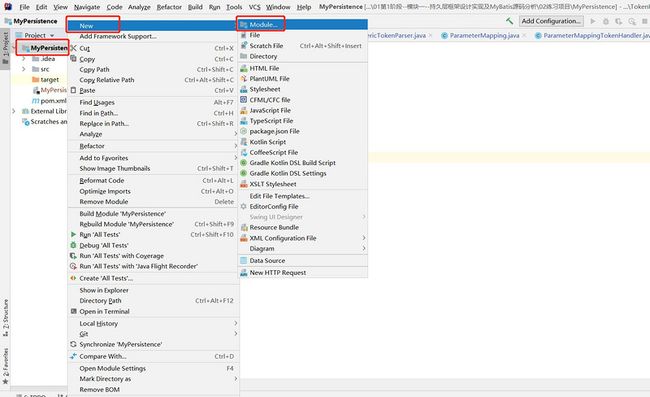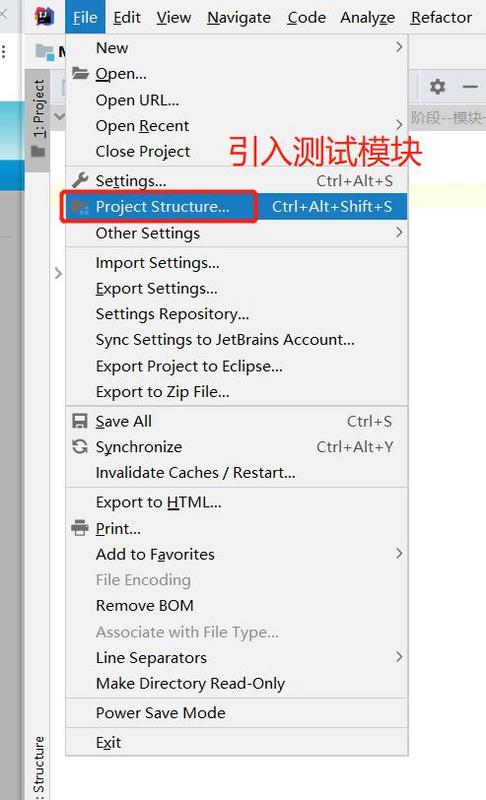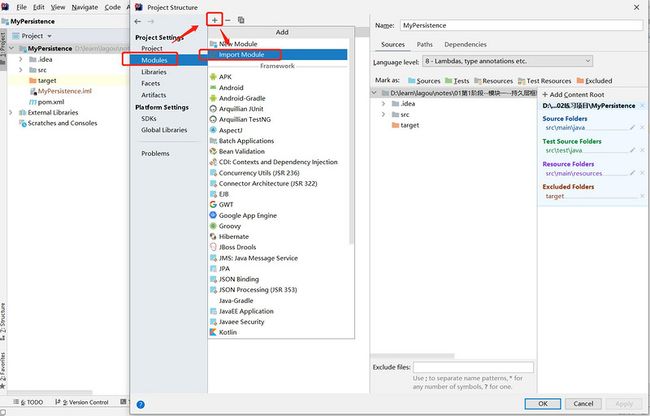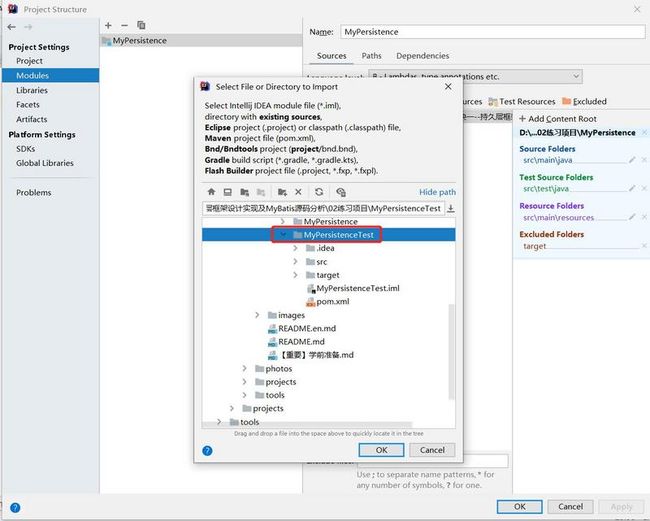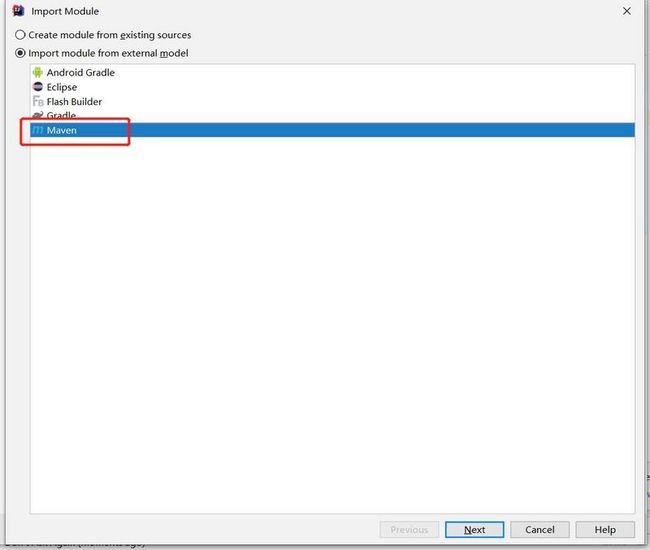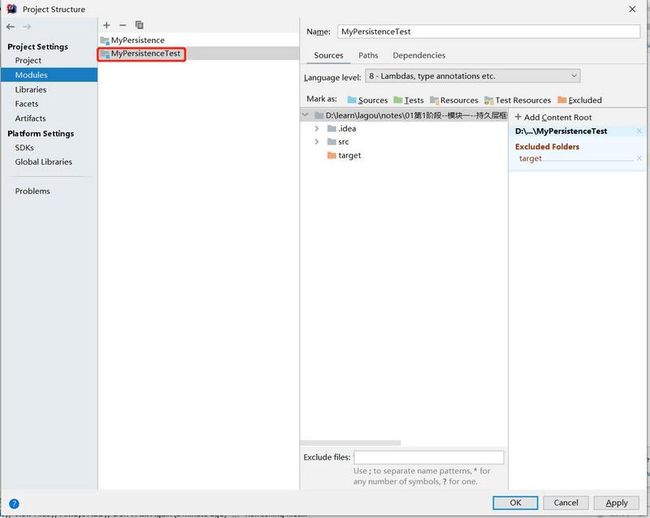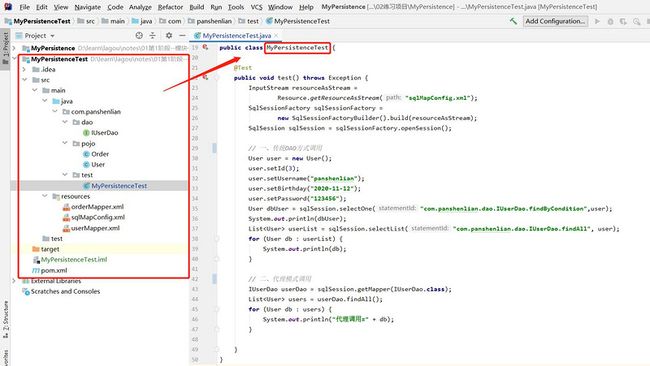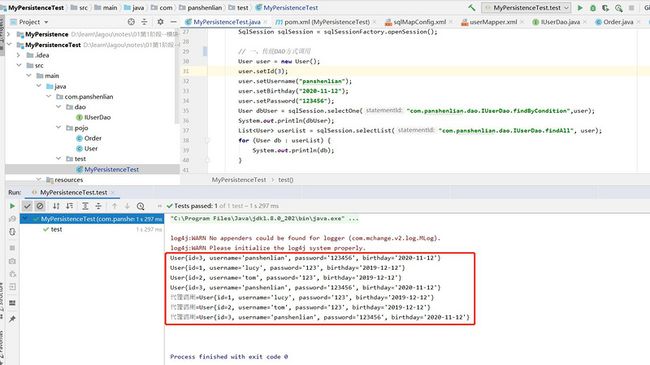封面 : 洛小汐
作者 : 潘潘
自毕业以后,自己先创业后上班,浮沉了近8年,内心着实焦躁,虽一直是走科班路线,但在技术道路上却始终没静下心来研究、思考、梳理,机会来了,便抓牢。
希望自己记录下来的知识内容,对后来的学习之人,能有些许帮助。
对文章内容有任何建议或意见,或对互联网开发有希望交流学习,或单纯热爱生活,都欢迎随时微信我:panshenlian。
第一个系列的文章主要围绕「架构师(Java)技术条线」展开聊,不定时更新。
第一篇我以《手写一套持久层框架》先来打个样,本篇文章我们先不介绍MyBatis,也不会分析源码,我们先聊一个 Java API:JDBC。
JDBC是Java的老朋友,我们再一次认识他吧,挑挑他的毛病,站在Java资老朋友的角度,给他提点优化意见,并送他一套《自定义持久层框架》。
温馨提示:如果大家在阅读过程中,对某些解决思路存在疑问,我建议大家先带着疑问阅读完,消化理解,因为导师们确实是通过研究Mybatis等持久层框架源码之后,反过来剖析的。
简单来说 “ 大厂都这么写,我们且这么跟随吧 ”。
Mybaits系列全解 (持续更新)
- Mybatis系列全解(一):手写一套持久层框架
- Mybatis系列全解(二):Mybatis简介与环境搭建
- Mybatis系列全解(三):Mybatis简单CRUD使用介绍
- Mybatis系列全解(四):全网最全!Mybatis配置文件XML全貌详解
- Mybatis系列全解(五):全网最全!详解Mybatis的Mapper映射文件
- Mybatis系列全解(六):Mybatis最硬核的API你知道几个?
- Mybatis系列全解(七):全息视角看Dao层两种实现方式之传统方式与代理方式
- Mybatis系列全解(八):Mybatis的动态SQL
- Mybatis系列全解(九):Mybatis的复杂映射
- Mybatis系列全解(十):Mybatis注解开发
- Mybatis系列全解(十一):Mybatis缓存全解
- Mybatis系列全解(十二):Mybatis插件开发
- Mybatis系列全解(十三):Mybatis代码生成器
- Mybatis系列全解(十四):Spring集成Mybatis
- Mybatis系列全解(十五):SpringBoot集成Mybatis
- Mybatis系列全解(十六):Mybatis源码剖析
一、JDBC是谁?
JDBC是谁?干啥的?到底有多能打?看看网络上的朋友们怎么说。
Java数据库连接,(Java Database Connectivity,简称JDBC)是Java语言中用来规范客户端程序如何来访问数据库的应用程序接口,提供了诸如查询和更新数据库中数据的方法。-- 来自百度百科
JDBC(Java DataBase Connectivity,java数据库连接)是一种用于执行SQL语句的Java API,可以为多种关系数据库提供统一访问,它由一组用Java语言编写的类和接口组成。JDBC提供了一种基准,据此可以构建更高级的工具和接口,使数据库开发人员能够编写数据库应用程序。-- 来自360百科
... 无法访问此网站-- 来自维基百科
以上基本就是JDBC的大致介绍,官方且严谨的说辞,That's It , 我们往下看看,它曾经的高光时刻。
自从Java语言于1995年5月正式公布以来,Java风靡全球。出现大量的用java语言编写的程序,其中也包括数据库应用程序。由于没有一个Java语言的API,编程人员不得不在Java程序中加入C语言的ODBC函数调用。这就使很多Java的优秀特性无法充分发挥,比如平台无关性、面向对象特性等。随着越来越多的编程人员对Java语言的日益喜爱,越来越多的公司在Java程序开发上投入的精力日益增加,对java语言接口的访问数据库的API的要求越来越强烈。也由于ODBC的有其不足之处,比如它并不容易使用,没有面向对象的特性等等,SUN公司决定开发一Java语言为接口的数据库应用程序开发接口。在JDK1.x版本中,JDBC只是一个可选部件,到了JDK1.1公布时,SQL类包(也就是JDBCAPI)就成为Java语言的标准部件。后面从JDBC1.0到JDBC4.0,一路发展。
-- 来自网络
结合介绍说明加深我们对JDBC的了解。
不过,我想知道他平时是如何工作的?一张图 《 JDBC 基本架构 》 了解一下:
有了JDBC,向各种关系数据库发送SQL语句就是一件很容易的事。换言之,有了JDBC API,就不必为访问Sybase数据库专门写一个程序,为访问Oracle数据库又专门写一个程序,或为访问Mysql数据库又编写另一个程序等等,程序员只需用JDBC API写一个程序就够了,它可向相应数据库发送SQL调用。
同时,将Java语言和JDBC结合起来使程序员不必为不同的平台编写不同的应用程序,只须写一遍程序就可以让它在任何平台上运行,这也是Java语言"编写一次,处处运行"的优势。
我们再来看看他工作的细节。
毕竟,曾有人说过:想了解一个人,就得先仔细了解Ta的工作。
二、JDBC如何工作?
JDBC API 允许应用程序访问任何形式的表格数据,特别是存储在关系数据库中的数据。
执行流程主要分三步:
- 连接数据源。
- 为数据库传递查询和更新指令。
- 处理数据库响应并返回的结果。
但实际上,每步流程都特别细节:
使用流程 (详细说明)
1.加载数据库驱动:
程序中使用Class.forName('驱动')加载驱动,JVM会寻找并加载指定驱动类,同时执行驱动类的静态代码段,在JDK1.6之前JDBC规范中明确要求各家在实现Driver类时必须在静态代码段中向DriverManager注册实例,JDK1.6之后各家实现的Driver类则不再需要主动注册实例,因为DriverManager已经在初始化阶段对所有jar包中实现了java.sql.Driver的类进行扫描并进行初始化。
- 创建数据库连接:
DriverManager通过遍历所有已注册的驱动来尝试获取连接,第一个匹配上就会直接返回,并使用对应驱动建立起客户端与数据库服务器的网络连接(物理连接Socket了解一下)。
- 创建编译对象:
数据库连接connection成功之后,我们会向数据库发送一次请求(statement),执行一条sql语句,一个连接可以执行多次statement,除非你关闭连接,其中还有一个概念就是事务transaction,事务和请求可以是一对一,也可以是一对多,这取决于你是想把多个请求statement作为同一个事务提交,还是一个请求提交一次事务,JDBC默认是事务是自动提交,即auto-commit是打开的,所以默认是一对一。
- 设置入参执行SQL:
为了防止SQL注入,我们使用预处理在sql中使用?作为输入参数的占位符,sql在编译后成为安全的sql语句再进行查询(有缘我们可以聊聊为何预处理机制能防止SQL注入)。
- 封装返回结果集:
SQL执行之后会把结果集封装到ResultSet类,ResultSet类本身的迭代器初始行数的位置是1,所以我们会发现与java.util.Iterator接口的迭代初始行数为0有差异,同时ResultSet类本身没有提供hasNext方法,所以我们会不断的while(rs.next())往后定位,再通过不同的类型的访问器读取数据(例如getString,getInteger等)。
- 释放数据库连接资源:
考虑到数据库连接占用了数据库服务器的内存资源,所以不可能无限制建立连接,用完就释放,养成好习惯,目前很多成熟的数据连接池技术,很好的优化管理的数据连接问题。
我们通过一段简单的例子来演示一下使用流程,本例子使用JDBC操作mysql数据库,先看看我们最终的项目结构与JDBC API在JDK中rt.jar的结构:
- 项目结构:
- JDBC API在JDK中rt.jar的结构:
默认已具备java开发环境、mysql数据库
- 创建mave工程,并且引入mysql驱动依赖
mysql
mysql-connector-java
5.1.25
- 创建java测试类
package com.panshenlian.jdbc;
import com.panshenlian.po.User;
import java.sql.*;
/**
* @Author: panshenlian
* @Description: 演示通过JDBC连接mysql数据库
* @Date: Create in 20:11 2020/11/10
*/
public class Test01 {
public static void main(String[] args) {
User user = new User();
Connection connection = null;
PreparedStatement preparedStatement = null;
ResultSet resultSet = null;
try {
// 加载数据库驱动
Class.forName("com.mysql.jdbc.Driver");
// 通过驱动管理类获取数据库连接
connection =
DriverManager.getConnection(
"jdbc:mysql://localhost:3306/mybatis"+
"?characterEncoding=utf-8",
"root","123456");
// 定义SQL语句 ? 表示占位符
String sql = " select * from user where username = ? ";
// 获取预处理statement对象
preparedStatement = connection.prepareStatement(sql);
// 设置参数
// 第一个参数sql语句中参数的序号(从1开始)
// 第二个参数为设置的参数值
preparedStatement.setString(1,"panshenlian");
// 向数据库发出sql执行查询,查询出结果集
resultSet = preparedStatement.executeQuery();
// 遍历查询结果集
while(resultSet.next()){
int id = resultSet.getInt("id");
String name = resultSet.getString("username");
// 封装User
user.setId(id);
user.setUserName(name);
System.out.println(user);
}
} catch (Exception e) {
e.printStackTrace();
} finally {
// 释放资源
if(resultSet!=null){
try {
resultSet.close();
} catch (SQLException e) {
e.printStackTrace();
}
}
if(preparedStatement!=null){
try {
preparedStatement.close();
} catch (SQLException e) {
e.printStackTrace();
}
}
if(connection!=null){
try {
connection.close();
} catch (SQLException e) {
e.printStackTrace();
}
}
}
}
}
- 创建User类
package com.panshenlian.po;
/**
* @Author: panshenlian
* @Description: 用户实体
* @Date: Create in 20:10 2020/11/10
*/
public class User {
private Integer id;
private String userName;
public Integer getId() {
return id;
}
public void setId(Integer id) {
this.id = id;
}
public String getUserName() {
return userName;
}
public void setUserName(String userName) {
this.userName = userName;
}
@Override
public String toString() {
return "User{" +
"id=" + id +
", userName='" + userName + '\'' +
'}';
}
}
- 创建sql语句
-- ----------------------------
-- Table structure for user
-- ----------------------------
DROP TABLE IF EXISTS `user`;
CREATE TABLE `user` (
`id` int(11) NOT NULL AUTO_INCREMENT,
`username` varchar(50) DEFAULT NULL,
`password` varchar(50) DEFAULT NULL,
`birthday` varchar(50) DEFAULT NULL,
PRIMARY KEY (`id`)
) ENGINE=InnoDB AUTO_INCREMENT=3 DEFAULT CHARSET=utf8;
-- ----------------------------
-- Records of user
-- ----------------------------
INSERT INTO `user` VALUES ('1', 'senly', '123', '2020-11-10');
INSERT INTO `user` VALUES ('2', 'panshenlian', '123456', '2020-11-10');
- 执行结果,nice , 成功。
User{id=2, userName='panshenlian'}
看完这段演示,大家是否发现一个问题?就是整个JDBC操作数据库的使用过程繁琐而尴尬,就如这场对话:
额… JDBC你确实挺烦的。我懂你需要和数据库建立连接、执行SQL语句、处理查询结果集...
但是,这整个过程,能不能优化一下呢?
三、JDBC存在哪些待优化的地方?
我们平时瘦身增肌,工作更得提质增效,来,我们剖开代码,逐个分析:
// 加载数据库驱动
Class.forName("com.mysql.jdbc.Driver");
// 通过驱动管理类获取数据库链接
connection = DriverManager.getConnection(
"jdbc:mysql://localhost:3306/mybatis?characterEncoding=utf-8",
"root","123456");
存在问题1:数据库配置信息存在硬编码问题。
优化思路:使用配置文件!
存在问题2:频繁创建、释放数据库连接问题。
优化思路:使用数据连接池!
// 定义SQL语句 ? 表示占位符
String sql = " select * from user where username = ? ";
// 获取预处理statement对象
preparedStatement = connection.prepareStatement(sql);
// 设置参数,第一个参数sql语句中参数的序号(从1开始),第二个参数为设置的参数值
preparedStatement.setString(1,"tom");
// 向数据库发出sql执行查询,查询出结果集
resultSet = preparedStatement.executeQuery();
存在问题3:SQL语句、设置参数、获取结果集参数均存在硬编码问题 。
优化思路:使用配置文件!
// 遍历查询结果集
while(resultSet.next()){
int id = resultSet.getInt("id");
String userName = resultSet.getString("username");
// 封装User
user.setId(id);
user.setUserName(userName);
System.out.println(user);
}
存在问题4:手动封装返回结果集,较为繁琐。
优化思路:使用Java反射、自省!
针对JDBC各个环节中存在的不足,现在,我们整理出对应的优化思路,统一汇总:
| 存在问题 | 优化思路 |
|---|---|
| 数据库配置信息存在硬编码问题 | 使用配置文件 |
| 频繁创建、释放数据库连接问题 | 使用数据连接池 |
| SQL语句、设置参数、获取结果集参数均存在硬编码问题 | 使用配置文件 |
| 手动封装返回结果集,较为繁琐 | 使用Java反射、自省 |
假如让你来优化,你会根据这些优化思路如何设计一套持久层框架呢?
四、自定义持久层框架:思路分析
JDBC是个人作战,凡事亲力亲为,低效而高险,自己加载驱动,自己建连接,自己 ...
而持久层框架好比是多工种协作,分工明确,执行高效,有专门负责解析注册驱动建立连接的,有专门管理数据连接池的,有专门执行sql语句的,有专门做预处理参数的,有专门装配结果集的 ...
框架的作用,就是为了帮助我们减去繁重开发细节与冗余代码,使我们能更加专注于业务应用开发。
来,我们一起看看使用JDBC和使用持久层框架有什么区别?
使用框架对于我们使用者(主要是研发人员),是有多舒爽呢?
是不是发现,拥有这么一套持久层框架是如此舒适,我们仅仅需要干两件事:
- 配置数据源(地址/数据名/用户名/密码)
- 编写SQL与参数准备(SQL语句/参数类型/返回值类型)
框架,除了思考本身的工程设计,还需要考虑到实际项目端的使用场景,干系方涉及两端:
- 使用端(实际项目)
- 持久层框架本身
以上两步,我们通过一张架构图《 手写持久层框架基本思路 》来梳理清楚:
核心接口/类重点说明:
| 分工协作 | 角色定位 | 类名定义 |
|---|---|---|
| 负责读取配置文件 | 资源辅助类 | Resources |
| 负责存储数据库连接信息 | 数据库资源类 | Configuration |
| 负责存储SQL映射定义、存储结果集映射定义 | SQL与结果集资源类 | MappedStatement |
| 负责解析配置文件,创建会话工厂SqlSessionFactory | 会话工厂构建者 | SqlSessionFactoryBuilder |
| 负责创建会话SqlSession | 会话工厂 | SqlSessionFactory |
| 指派执行器Executor | 会话 | SqlSession |
| 负责执行SQL (配合指定资源Mapped Statement) | 执行器 | Executor |
正常来说项目只对应一套数据库环境,一般对应一个SqlSessionFactory实例对象,我们使用单例模式只创建一个SqlSessionFactory实例。如果需要配置多套数据库环境,那需要做一些拓展,例如Mybatis中通过environments等配置就可以支持多套测试/生产数据库环境进行切换。
梳理完持久层框架的基本思路,明确了框架各角色分工,我们开始梳理详细方案:
A、项目使用端,调用框架API,除了引入持久层框架的jar包之外,还需额外提供两部分配置信息:
1. sqlMapConfig.xml : 数据库配置信息(地址/数据名/用户名/密码),以及mapper.xml的全路径。
2. mapper.xml : SQL配置信息,存放SQL语句、参数类型、返回值类型相关信息。
B、框架本身,实质上就是对JDBC代码进行封装,基本6步:
- 加载配置文件:根据配置文件的路径,加载配置文件成字节输入流,存储在内存中。
创建Resource类,提供加载流方法:InputStream getResourceAsStream(String path)
- 创建两个javaBean(容器对象):存放配置文件解析出来的内容
Configuration(核心配置类):存放sqlMapConfig.xml解析出来的内容。
MappedStatement(映射配置类):存放mapper.xml解析出来的内容。
- 解析配置文件(使用dom4j) ,并创建SqlSession会话对象
创建类:SqlSessionFactoryBuilder 方法:build(InputStream in)
> 使用dom4j解析配置文件,将解析出来的内容封装到容器对象中
> 创建SqlSessionFactory对象,生产sqlSession会话对象(工厂模式)
- 创建SqlSessionFactory接口以及实现类DefaultSqlSessionFactory
创建openSession()接口方法,生产sqlSession
- 创建SqlSession接口以及实现类DefaultSqlSession
定义对数据库的CRUD操作:
> selectList();
> selectOne();
> update();
> delete();
- 创建Executor接口以及实现类SimpleExecutor
创建query(Configuration conf,MappedStatement ms,Object... params)
实际执行的就是JDBC代码。
基本过程我们已经清晰,我们再细化一下类图,更好的助于我们实际编码:
简约版
详细版
最终手写的持久层框架结构参考:
包接口类说明
- config包
| 接口/类 | 作用 |
|---|---|
| BoundSql | 保存Sql语句的对象,替换sql#{}成为?号并且存储#{}对应的参数名 |
| XMLConfigBuilder | SqlMapConfig.xml配置文件解析工具类 |
| XMLMapperBuilder | Mapper.xml配置文件解析工具类 |
- io包
| 接口/类 | 作用 |
|---|---|
| Resource | 读取SqlMapConfig.xml和Mapper.xml的工具类,转换为输入流inputStream |
- pojo包
| 接口/类 | 作用 |
|---|---|
| Configuration | 封装SqlMapConfig.xml配置参数 |
| MappedStatement | 封装Mapper.xml配置的sql参数 |
- sqlSession包
| 接口/类 | 作用 |
|---|---|
| SqlSessionFactoryBuilder | SqlSessionFactory构建者类 |
| SqlSessionFactory | 生产SqlSession的工厂接口 |
| DefaultSqlSessionFactory | SqlSessionFactory的默认实现类 |
| SqlSession | SqlSession接口定义数据库基本的CRUD方法 |
| DefaultSqlSession | SqlSession的实现类 |
| Executor | Executor接口sql的真正执行者,使用JDBC操作数据库 |
| SimpleExecutor | Executor的实现类 |
- utils
| 接口/类 | 作用 |
|---|---|
| ParameterMapping | 来源于Mybatis框架,SQL参数映射类,存储#{}、${}中的参数名 |
| TokenHandler | 来源于Mybatis框架,标记处理器接口 |
| ParameterMappingTokenHandler | 来源于Mybatis框架,标记处理器实现类,解析#{}、${}成为? |
| GenericTokenParser | 来源于Mybatis框架,通用标记解析器,标记#{与}开始结束处理 |
五、自定义持久层框架:编码
结合UML图和项目结构图,脑海里开始有点东西了,烧脑且枯燥的编码过程,我们开始吧。
框架依赖 pom.xml
4.0.0
com.panshenlian
MyPersistence
1.0-SNAPSHOT
UTF-8
UTF-8
1.8
1.8
1.8
mysql
mysql-connector-java
5.1.17
c3p0
c3p0
0.9.1.2
log4j
log4j
1.2.12
junit
junit
4.10
dom4j
dom4j
1.6.1
jaxen
jaxen
1.1.6
config包下BoundSql类
package com.panshenlian.config;
import com.panshenlian.utils.ParameterMapping;
import java.util.ArrayList;
import java.util.List;
/**
* @Author: panshenlian
* @Description: SQL通配类
* @Date: Create in 16:12 2020/11/12
*/
public class BoundSql {
/**
* 解析过的sql语句
*/
private String sqlText;
private List parameterMappingList =
new ArrayList();
public BoundSql(String sqlText, List parameterMappingList) {
this.sqlText = sqlText;
this.parameterMappingList = parameterMappingList;
}
public String getSqlText() {
return sqlText;
}
public void setSqlText(String sqlText) {
this.sqlText = sqlText;
}
public List getParameterMappingList() {
return parameterMappingList;
}
public void setParameterMappingList(List parameterMappingList) {
this.parameterMappingList = parameterMappingList;
}
}
config包下XMLConfigBuilder类
package com.panshenlian.config;
import com.mchange.v2.c3p0.ComboPooledDataSource;
import com.panshenlian.io.Resource;
import com.panshenlian.pojo.Configuration;
import com.sun.javafx.scene.control.skin.EmbeddedTextContextMenuContent;
import org.dom4j.Document;
import org.dom4j.DocumentException;
import org.dom4j.Element;
import org.dom4j.io.SAXReader;
import java.io.InputStream;
import java.util.List;
import java.util.Properties;
/**
* @Author: panshenlian
* @Description: 数据库配置信息解析类
* @Date: Create in 13:56 2020/11/12
*/
public class XMLConfigBuilder {
private Configuration configuration;
public XMLConfigBuilder() {
this.configuration = new Configuration();
}
public Configuration parseConfig(InputStream inputStream) throws Exception {
Document document = new SAXReader().read(inputStream);
Element configurationRootElement = document.getRootElement();
// 解析数据源配置dataSource下的参数信息
List elementList = configurationRootElement.selectNodes("//property");
Properties properties = new Properties();
for (Element element : elementList){
String name = element.attributeValue("name");
String value = element.attributeValue("value");
properties.put(name,value);
}
// 使用c3p0数据源
ComboPooledDataSource dataSource = new ComboPooledDataSource();
dataSource.setDriverClass(properties.getProperty("driverClass"));
dataSource.setJdbcUrl(properties.getProperty("jdbcUrl"));
dataSource.setUser(properties.getProperty("userName"));
dataSource.setPassword(properties.getProperty("password"));
// 设置数据源
configuration.setDataSource(dataSource);
// 解析mapper.xml,根据路径读取字节输入流,使用dom4j进行解析
List mapperElementList = configurationRootElement.selectNodes("//mapper");
for (Element element : mapperElementList) {
String mapperPath = element.attributeValue("resource");
InputStream resourceAsStream = Resource.getResourceAsStream(mapperPath);
XMLMapperBuilder xmlMapperBuilder = new XMLMapperBuilder(configuration);
xmlMapperBuilder.parseMapper(resourceAsStream);
}
return configuration;
}
}
config包下XMLMapperBuilder类
package com.panshenlian.config;
import com.panshenlian.pojo.Configuration;
import com.panshenlian.pojo.MappedStatement;
import org.dom4j.Document;
import org.dom4j.DocumentException;
import org.dom4j.Element;
import org.dom4j.io.SAXReader;
import java.io.InputStream;
import java.util.List;
/**
* @Author: panshenlian
* @Description: SQL配置信息解析类
* @Date: Create in 14:28 2020/11/12
*/
public class XMLMapperBuilder {
private Configuration configuration;
public XMLMapperBuilder(Configuration configuration) {
this.configuration = configuration;
}
public void parseMapper(InputStream inputStream) throws DocumentException {
Document mapperDocument = new SAXReader().read(inputStream);
Element rootElement = mapperDocument.getRootElement();
String namespace = rootElement.attributeValue("namespace");
// 解析每一个select节点
List selectNodes = mapperDocument.selectNodes("//select");
for (Element element : selectNodes) {
String id = element.attributeValue("id");
String resultType = element.attributeValue("resultType");
String parameterType = element.attributeValue("parameterType");
String sql = element.getTextTrim();
// 解析封装进入MapperdStatement对象
MappedStatement mappedStatement = new MappedStatement();
mappedStatement.setId(id);
mappedStatement.setResultType(resultType);
mappedStatement.setParameterType(parameterType);
mappedStatement.setSql(sql);
String statementId = namespace + "." + id;
configuration.getMappedStatementMap().put(statementId,mappedStatement);
}
}
}
io包下Resource工具类
package com.panshenlian.io;
import java.io.InputStream;
/**
* @Author: panshenlian
* @Description: 资源类
* @Date: Create in 9:22 2020/11/12
*/
public class Resource {
/**
* 根据配置文件路径,将配置文件加载成字节输入流,存储在内存中
* @param path
* @return
*/
public static InputStream getResourceAsStream(String path){
InputStream inputStream = Resource.class.getClassLoader().getResourceAsStream(path);
return inputStream;
}
}
pojo包下Configuration
package com.panshenlian.pojo;
import javax.sql.DataSource;
import java.util.HashMap;
import java.util.Map;
/**
* @Author: panshenlian
* @Description: 数据库配置类
* @Date: Create in 13:58 2020/11/12
*/
public class Configuration {
private DataSource dataSource;
/**
* key:statementId
* value:封装好的mappedStatement对象
*/
private Map mappedStatementMap = new HashMap();
public DataSource getDataSource() {
return dataSource;
}
public void setDataSource(DataSource dataSource) {
this.dataSource = dataSource;
}
public Map getMappedStatementMap() {
return mappedStatementMap;
}
public void setMappedStatementMap(Map mappedStatementMap) {
this.mappedStatementMap = mappedStatementMap;
}
}
pojo包下MappedStatement
package com.panshenlian.pojo;
/**
* @Author: panshenlian
* @Description: SQL与结果集资源类 (负责存储SQL映射定义、存储结果集映射定义)
* @Date: Create in 14:17 2020/11/12
*/
public class MappedStatement {
/**
* id标识
*/
private String id;
/**
* 返回值类型
*/
private String resultType;
/**
* 参数值类型
*/
private String parameterType;
/**
* sql语句
*/
private String sql;
public String getId() {
return id;
}
public void setId(String id) {
this.id = id;
}
public String getResultType() {
return resultType;
}
public void setResultType(String resultType) {
this.resultType = resultType;
}
public String getParameterType() {
return parameterType;
}
public void setParameterType(String parameterType) {
this.parameterType = parameterType;
}
public String getSql() {
return sql;
}
public void setSql(String sql) {
this.sql = sql;
}
}
sqlSession包下DefaultSqlSession
package com.panshenlian.sqlSession;
import com.panshenlian.pojo.Configuration;
import com.panshenlian.pojo.MappedStatement;
import java.lang.reflect.*;
import java.util.List;
/**
* @Author: panshenlian
* @Description: sql会话实现类
* @Date: Create in 14:43 2020/11/12
*/
public class DefaultSqlSession implements SqlSession{
private Configuration configuration;
public DefaultSqlSession(Configuration configuration) {
this.configuration = configuration;
}
@Override
public List selectList(String statementId, Object... params) throws Exception {
// 1、构建sql执行器
SimpleExecutor simpleExecutor = new SimpleExecutor();
// 2、获取最终执行sql对象
MappedStatement mappedStatement = configuration.getMappedStatementMap().get(statementId);
// 3、执行sql,返回结果集
List sqlSession包下DefaultSqlSessionFactory
package com.panshenlian.sqlSession;
import com.panshenlian.pojo.Configuration;
/**
* @Author: panshenlian
* @Description: 默认SqlSession工厂实现类
* @Date: Create in 14:41 2020/11/12
*/
public class DefaultSqlSessionFactory implements SqlSessionFactory{
private Configuration configuration;
public DefaultSqlSessionFactory(Configuration configuration) {
this.configuration = configuration;
}
@Override
public SqlSession openSession() {
return new DefaultSqlSession(configuration);
}
}
sqlSession包下Executor
package com.panshenlian.sqlSession;
import com.panshenlian.pojo.Configuration;
import com.panshenlian.pojo.MappedStatement;
import java.beans.IntrospectionException;
import java.lang.reflect.InvocationTargetException;
import java.sql.SQLException;
import java.util.List;
/**
* @Author: panshenlian
* @Description: sql执行器接口
* @Date: Create in 15:02 2020/11/12
*/
public interface Executor {
public List query(Configuration configuration,
MappedStatement mappedStatement,
Object... params) throws Exception;
}
sqlSession包下SimpleExecutor
package com.panshenlian.sqlSession;
import com.mysql.jdbc.StringUtils;
import com.panshenlian.config.BoundSql;
import com.panshenlian.pojo.Configuration;
import com.panshenlian.pojo.MappedStatement;
import com.panshenlian.utils.GenericTokenParser;
import com.panshenlian.utils.ParameterMapping;
import com.panshenlian.utils.ParameterMappingTokenHandler;
import java.beans.ExceptionListener;
import java.beans.IntrospectionException;
import java.beans.PropertyDescriptor;
import java.lang.reflect.Field;
import java.lang.reflect.InvocationTargetException;
import java.lang.reflect.Method;
import java.sql.*;
import java.util.ArrayList;
import java.util.List;
/**
* @Author: panshenlian
* @Description: sql执行器接口简单实现类
* @Date: Create in 15:55 2020/11/12
*/
public class SimpleExecutor implements Executor {
@Override
public List query(Configuration configuration,
MappedStatement mappedStatement,
Object... params) throws Exception {
// 1、注册驱动 , 获取数据库连接
Connection connection = configuration.getDataSource().getConnection();
// 2、获取sql语句: select * from user where id = #{id}
// 转换sql语句: select * from user where id = ?
// 转换的过程,还需要对#{}里面的值进行解析存储
String sql = mappedStatement.getSql();
BoundSql bounSql = getBoundSql(sql);
// 3、获取预处理对象: preparedStatement
PreparedStatement preparedStatement =
connection.prepareStatement(bounSql.getSqlText());
// 4、设置参数,通过反射机制获取到参数
String parameterType = mappedStatement.getParameterType();
Class parameterTypeClass = getClassType(parameterType);
List parameterMappingList =
bounSql.getParameterMappingList();
for (int i = 0; i < parameterMappingList.size(); i++) {
ParameterMapping parameterMapping = parameterMappingList.get(i);
String filedName = parameterMapping.getContent();
// 反射
Field declaredField = parameterTypeClass.getDeclaredField(filedName);
// 暴力访问
declaredField.setAccessible(true);
Object declaredFieldValue = declaredField.get(params[0]); // params[0] 是对象
preparedStatement.setObject(i+1,declaredFieldValue);
}
// 5、执行SQL
ResultSet resultSet = preparedStatement.executeQuery();
String resultType = mappedStatement.getResultType();
Class resultTypeClass = getClassType(resultType);
List objects = new ArrayList();
// 6、封装返回结果集
while (resultSet.next()){
Object o = resultTypeClass.newInstance();
// 元数据
ResultSetMetaData metaData = resultSet.getMetaData();
for (int i = 1; i <= metaData.getColumnCount(); i++) {
// 字段名
String columnName = metaData.getColumnName(i);
// 字段值
Object columnValue = resultSet.getObject(columnName);
// 使用内省(反射),根据数据库表和实体的对应关系,完成封装
PropertyDescriptor propertyDescriptor =
new PropertyDescriptor(columnName, resultTypeClass);
Method writeMethod = propertyDescriptor.getWriteMethod();
writeMethod.invoke(o,columnValue);
}
objects.add(o);
}
return (List)objects;
}
/**
* 根据参数的全路径反射获取类
* @param parameterType
* @return
*/
private Class getClassType(String parameterType) throws ClassNotFoundException {
if (StringUtils.isNullOrEmpty(parameterType)) {
return null;
}
Class clazz = Class.forName(parameterType);
return clazz;
}
/**
* 完成对#{}的解析工作:1、将#{}使用?进行代替,2、解析出#{}里面的值并存储
* @param sql
* @return
*/
private BoundSql getBoundSql(String sql) {
// 标记处理类,配置标记解析器来完成对占位符的解析处理工作
ParameterMappingTokenHandler parameterMappingTokenHandler
= new ParameterMappingTokenHandler();
GenericTokenParser genericTokenParser =
new GenericTokenParser("#{","}",
parameterMappingTokenHandler);
// 解析出来的sql
String parseSql = genericTokenParser.parse(sql);
// 解析出来的参数名称
List parameterMappings =
parameterMappingTokenHandler.getParameterMappings();
// 封装成为通配sql返回结果
BoundSql boundSql = new BoundSql(parseSql, parameterMappings);
return boundSql;
}
}
sqlSession包下SqlSession
package com.panshenlian.sqlSession;
import java.util.List;
/**
* @Author: panshenlian
* @Description: Sql会话接口
* @Date: Create in 14:40 2020/11/12
*/
public interface SqlSession {
/**
* 查询所有
* @param statementId
* @param params
* @param
* @return
*/
public List selectList(String statementId , Object ... params) throws Exception;
/**
* 根据条件查询单个
* @param statementId
* @param params
* @param
* @return
*/
public T selectOne(String statementId , Object ... params) throws Exception;
/**
* 根据条件更新
* @param statementId
* @param params
* @return
*/
public int update(String statementId , Object ... params);
/**
* 根据条件删除
* @param statementId
* @param params
* @return
*/
public int delete(String statementId , Object ... params);
/**
* 为Dao接口生成代理实现类
* @param mapperClass
* @param
* @return
*/
public T getMapper(Class mapperClass);
}
sqlSession包下SqlSessionFactory
package com.panshenlian.sqlSession;
/**
* @Author: panshenlian
* @Description: SqlSession工厂接口
* @Date: Create in 13:51 2020/11/12
*/
public interface SqlSessionFactory {
public SqlSession openSession();
}
sqlSession包下SqlSessionFactoryBuilder
package com.panshenlian.sqlSession;
import com.panshenlian.config.XMLConfigBuilder;
import com.panshenlian.pojo.Configuration;
import java.io.InputStream;
/**
* @Author: panshenlian
* @Description: SqlSession会话工厂构建类
* @Date: Create in 13:48 2020/11/12
*/
public class SqlSessionFactoryBuilder {
public SqlSessionFactory build(InputStream inputStream) throws Exception {
// 第一步:用dom4j解析配置文件,将解析出来的内容封装到Configuration中
XMLConfigBuilder xmlConfigBuilder = new XMLConfigBuilder();
Configuration configuration = xmlConfigBuilder.parseConfig(inputStream);
// 第二步:创建SqlSessionFactory对象,生产sqlSession会话对象(工厂模式)
DefaultSqlSessionFactory defaultSqlSessionFactory =
new DefaultSqlSessionFactory(configuration);
return defaultSqlSessionFactory;
}
}
utils包下GenericTokenParser
/**
* Copyright 2009-2017 the original author or authors.
*
* Licensed under the Apache License, Version 2.0 (the "License");
* you may not use this file except in compliance with the License.
* You may obtain a copy of the License at
*
* http://www.apache.org/licenses/LICENSE-2.0
*
* Unless required by applicable law or agreed to in writing, software
* distributed under the License is distributed on an "AS IS" BASIS,
* WITHOUT WARRANTIES OR CONDITIONS OF ANY KIND, either express or implied.
* See the License for the specific language governing permissions and
* limitations under the License.
*/
package com.panshenlian.utils;
/**
* 通用标记解析器,标记#{与}开始结束处理
* @author Clinton Begin
*/
public class GenericTokenParser {
private final String openToken; //开始标记
private final String closeToken; //结束标记
private final TokenHandler handler; //标记处理器
public GenericTokenParser(String openToken, String closeToken, TokenHandler handler) {
this.openToken = openToken;
this.closeToken = closeToken;
this.handler = handler;
}
/**
* 解析${}和#{}
* @param text
* @return
* 该方法主要实现了配置文件、脚本等片段中占位符的解析、处理工作,并返回最终需要的数据。
* 其中,解析工作由该方法完成,处理工作是由处理器handler的handleToken()方法来实现
*/
public String parse(String text) {
// 验证参数问题,如果是null,就返回空字符串。
if (text == null || text.isEmpty()) {
return "";
}
// 下面继续验证是否包含开始标签,如果不包含,默认不是占位符,直接原样返回即可,否则继续执行。
int start = text.indexOf(openToken, 0);
if (start == -1) {
return text;
}
// 把text转成字符数组src,并且定义默认偏移量offset=0、存储最终需要返回字符串的变量builder,
// text变量中占位符对应的变量名expression。判断start是否大于-1(即text中是否存在openToken),如果存在就执行下面代码
char[] src = text.toCharArray();
int offset = 0;
final StringBuilder builder = new StringBuilder();
StringBuilder expression = null;
while (start > -1) {
// 判断如果开始标记前如果有转义字符,就不作为openToken进行处理,否则继续处理
if (start > 0 && src[start - 1] == '\\') {
builder.append(src, offset, start - offset - 1).append(openToken);
offset = start + openToken.length();
} else {
//重置expression变量,避免空指针或者老数据干扰。
if (expression == null) {
expression = new StringBuilder();
} else {
expression.setLength(0);
}
builder.append(src, offset, start - offset);
offset = start + openToken.length();
int end = text.indexOf(closeToken, offset);
while (end > -1) {////存在结束标记时
if (end > offset && src[end - 1] == '\\') {//如果结束标记前面有转义字符时
// this close token is escaped. remove the backslash and continue.
expression.append(src, offset, end - offset - 1).append(closeToken);
offset = end + closeToken.length();
end = text.indexOf(closeToken, offset);
} else {//不存在转义字符,即需要作为参数进行处理
expression.append(src, offset, end - offset);
offset = end + closeToken.length();
break;
}
}
if (end == -1) {
// close token was not found.
builder.append(src, start, src.length - start);
offset = src.length;
} else {
//首先根据参数的key(即expression)进行参数处理,返回?作为占位符
builder.append(handler.handleToken(expression.toString()));
offset = end + closeToken.length();
}
}
start = text.indexOf(openToken, offset);
}
if (offset < src.length) {
builder.append(src, offset, src.length - offset);
}
return builder.toString();
}
}
utils包下ParameterMapping
package com.panshenlian.utils;
/**
* @Author: panshenlian
* @Description: 参数映射类(SQL参数映射类,存储#{}、${}中的参数名)
* @Date: Create in 16:14 2020/11/12
*/
public class ParameterMapping {
private String content;
public ParameterMapping(String content) {
this.content = content;
}
public String getContent() {
return content;
}
public void setContent(String content) {
this.content = content;
}
}
utils包下ParameterMappingTokenHandler
package com.panshenlian.utils;
import java.util.ArrayList;
import java.util.List;
/**
* 标记处理器实现类,解析#{}、${}成为?
*/
public class ParameterMappingTokenHandler implements TokenHandler {
private List parameterMappings = new ArrayList();
// context是参数名称 #{id} #{username}
public String handleToken(String content) {
parameterMappings.add(buildParameterMapping(content));
return "?";
}
private ParameterMapping buildParameterMapping(String content) {
ParameterMapping parameterMapping = new ParameterMapping(content);
return parameterMapping;
}
public List getParameterMappings() {
return parameterMappings;
}
public void setParameterMappings(List parameterMappings) {
this.parameterMappings = parameterMappings;
}
}
utils包下TokenHandler
/**
* Copyright 2009-2015 the original author or authors.
*
* Licensed under the Apache License, Version 2.0 (the "License");
* you may not use this file except in compliance with the License.
* You may obtain a copy of the License at
*
* http://www.apache.org/licenses/LICENSE-2.0
*
* Unless required by applicable law or agreed to in writing, software
* distributed under the License is distributed on an "AS IS" BASIS,
* WITHOUT WARRANTIES OR CONDITIONS OF ANY KIND, either express or implied.
* See the License for the specific language governing permissions and
* limitations under the License.
*/
package com.panshenlian.utils;
/**
* 标记处理器接口
* @author Clinton Begin
*/
public interface TokenHandler {
String handleToken(String content);
}
框架书写好了,我们写一个测试工程验证一下框架,我们在现有框架下新加一个测试项目(以module模块的方式创建)保证测试工程和框架项目在一个工作组下面:
由于我已经写好了测试工程,我直接引入即可,效果都一样,创建和引入都以module方式就可以:
测试工程基本流程也说明一下:
1、引入依赖pom.xml
4.0.0
com.panshenlian
MyPersistenceTest
1.0-SNAPSHOT
UTF-8
UTF-8
1.8
1.8
1.8
com.panshenlian
MyPersistence
1.0-SNAPSHOT
2、配置数据源sqlMapConfig.xml
3、我们以用户表为例子,建立用户sql配置userMapper.xml
4、用户dao接口
package com.panshenlian.dao;
import com.panshenlian.pojo.User;
import java.util.List;
/**
* @Author: panshenlian
* @Description:
* @Date: Create in 21:35 2020/11/12
*/
public interface IUserDao {
/**
* 查询所有用户
* @return
* @throws Exception
*/
public List findAll() throws Exception;
/**
* 根据条件进行用户查询
* @return
* @throws Exception
*/
public User findByCondition(User user) throws Exception;
}
5、用户dao的实体类
package com.panshenlian.pojo;
/**
* @Author: panshenlian
* @Description: 用户实体
* @Date: Create in 9:20 2020/11/12
*/
public class User {
private Integer id;
private String username;
private String password;
private String birthday;
public String getPassword() {
return password;
}
public void setPassword(String password) {
this.password = password;
}
public String getBirthday() {
return birthday;
}
public void setBirthday(String birthday) {
this.birthday = birthday;
}
public Integer getId() {
return id;
}
public void setId(Integer id) {
this.id = id;
}
public String getUsername() {
return username;
}
public void setUsername(String username) {
this.username = username;
}
@Override
public String toString() {
return "User{" +
"id=" + id +
", username='" + username + '\'' +
", password='" + password + '\'' +
", birthday='" + birthday + '\'' +
'}';
}
}
注意:用户sql配置文件userMapper.xml中的namespace需要和用户dao的全限定名一致,这是我们框架默认规则:namespace="com.panshenlian.dao.IUserDao" 同时select标签的id和用户dao接口的方法名保持一致,也是框架默认的规则,例如id="findAll"
6、最终我们创建测试类:MyPersistenceTest
package com.panshenlian.test;
import com.panshenlian.dao.IUserDao;
import com.panshenlian.io.Resource;
import com.panshenlian.pojo.User;
import com.panshenlian.sqlSession.SqlSession;
import com.panshenlian.sqlSession.SqlSessionFactory;
import com.panshenlian.sqlSession.SqlSessionFactoryBuilder;
import org.junit.Test;
import java.io.InputStream;
import java.util.List;
/**
* @Author: panshenlian
* @Description: 持久层框架测试类
* @Date: Create in 9:24 2020/11/12
*/
public class MyPersistenceTest {
@Test
public void test() throws Exception {
InputStream resourceAsStream =
Resource.getResourceAsStream("sqlMapConfig.xml");
SqlSessionFactory sqlSessionFactory =
new SqlSessionFactoryBuilder().build(resourceAsStream);
SqlSession sqlSession = sqlSessionFactory.openSession();
// 一、传统DAO方式调用
User user = new User();
user.setId(3);
user.setUsername("panshenlian");
user.setBirthday("2020-11-12");
user.setPassword("123456");
User dbUser = sqlSession.selectOne("com.panshenlian.dao.IUserDao.findByCondition",user);
System.out.println(dbUser);
List userList = sqlSession.selectList("com.panshenlian.dao.IUserDao.findAll", user);
for (User db : userList) {
System.out.println(db);
}
// 二、代理模式调用
IUserDao userDao = sqlSession.getMapper(IUserDao.class);
List users = userDao.findAll();
for (User db : users) {
System.out.println("代理调用=" + db);
}
}
}
7、运行测试类,结果符合预期
框架和测试验证我们基本完成,其实以上主要是对于持久层框架的一个简单框架介绍,方面我们以后学习分析Mybatis框架,基本我们做到了一个模拟雏形,流程大致是这样。
编码实现过程中涉及到几个有意思的知识点,我们后续找时间聊聊,包括:
- 内省机制
- 反射机制
- JDK动态代理
- 设计模式
- 泛型
总结
如今大型项目一般都不会直接使用JDBC,要么采用市面上成熟的持久层方案,要么自研持久层框架,说到底,还是单纯的JDBC无法保证高效高稳定性能的数据层访问与应用,而越来越多持久层框架方案,不仅消除了大量的JDBC冗余代码,还提供极低的学习曲线,既能保证协同传统的数据库还接受SQL语句,也为其他框架提供了拓展集成支持,包括连接池、缓存、性能等都做了极大的优化与提升,所以框架大行其道是必然趋势。
JDBC在90年代诞生之初也是高光而伟大,只不过随着技术水平的跃迁和业务场景的迭代更新,旧技术满足不了现有的诉求,所有事物都会轮换更新,我们仅仅是站在伟人的肩膀上,顺势变迁。
好,本篇完。下一篇,我们或许会聊聊 Mybatis基础和架构 。
/ End.
![]()
BIU ~ 文章持续更新,微信搜索「 潘潘和他的朋友们」第一时间阅读,随时有惊喜。本文会在 GitHub https://github.com/JavaWorld 收录,热腾腾的技术、框架、面经、解决方案,我们都会以最美的姿势第一时间送达,欢迎 Star。



